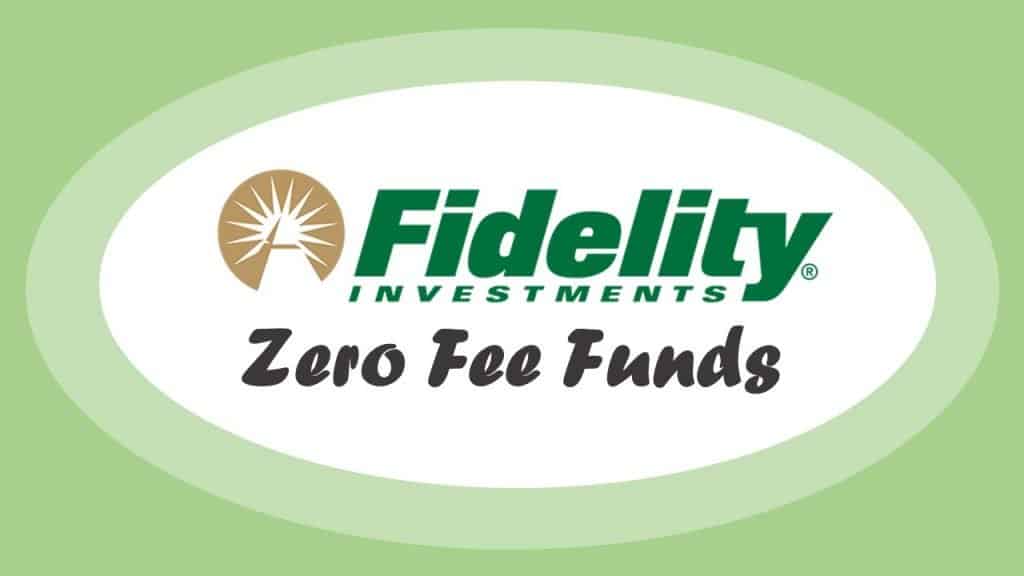Did I read that word right? Free, you say? Whenever we hear the word “Free,” we think there must be some gimmick. There is something that they are trying to sell us to get our money, but is Fidelity giving us something free? What’s the deal with the Fidelity Zero Fee Funds?
Thinking about this long and hard, I can only see one reason to give these funds away for free. That is gaining more customers. We can see how it costs money to work with other brokerages. VTSAX over at Vanguard cost us 0.04% on their best index fund. Fidelity has a similar fund called FZROX, having a 0.00% expense ratio. That saves us $4 on every $10,000 invested. That could add up.
Seriously, what are these so-called Fidelity Zero Fee Funds? Why are they so popular?
Fidelity Zero Fee Funds:
There are four Fidelity Zero Fee Funds out there. They each have a specific part of the market they track. The cool thing is that there are zero fees attached to them. So they have a 0% expense ratio on each fund, and there is a minimum investment of $0. If you look at the other Fidelity index funds, you will notice their expense ratios. Fidelity makes money off the expense ratios, and with these Fidelity Zero Fee Funds, they are making zero off of them.
These are just some great starter mutual funds that copy some of the indexes. They have low expenses; they perform passively and they are not actively managed. This is a great way to get started on your investing journey.
So let’s break down each one.
FZROX: The Fidelity ZERO Total Market Index Fund
This is probably the best of the Fidelity Zero Fee funds. People flock to this fund because it covers the total stock market index. Essentially, it will be investing in almost every major company in the U.S, and I say essentially. It invests in about 2500 different companies.
It is trying to compare itself to the Russel 3000 fund, but Fidelity has some requirements to get into this fund. It is primarily composed of large-cap and small-cap companies with a market cap above $75 million with a trading volume of $25 million every six months.
When people compare this fund, you could compare it to Fidelity’s own FSKAX, a total stock market index fund, but most people want to see the comparison between VTSAX and FZROX. VTSAX is from Vanguard and offers a competitor against the Fidelity funds.
FNILX: Fidelity ZERO Large Cap Index Fund
This is probably the biggest and most popular of the Fidelity Zero Fee funds. It has one thing that everyone wants, the S&P 500. So if you look closely at the fund, it is a mere copy of the S&P 500. It does not advertise or bear the name of the S&P 500 because if it did, Fidelity would have to pay a fee for the name.
Fidelity uses the name “Large Cap Index Fund” to save money on the fund in a cost-saving measure. This fund does not give it the most accurate match of the S&P 500, and it lags at about 0.08%. As the fund grows and gets more significant, it will continue to get closer and closer to matching the whole index.
The one thing Fidelity is doing is bringing in more people that want that S&P 500 index fund at a low cost. Vanguard offers their VFIAX fund that has an expense ratio of 0.04%. Fidelity saves money by cutting the name off the fund while providing a copycat version to sell to new and existing customers.
FZIPX: Fidelity ZERO Extended Market Index Fund
This fund is the small-caps fund to pair with the large caps fund. It holds 2000 companies together. At this point, you could combine FNILX and FZIPX and create the fund FZROX. Those two funds would be equal to 2500 companies.
It is another knockoff of the small-cap Russel 3000 fund, and it is picking up the other small-cap funds that are not included in the S&P 500. The companies allowed in must have a market cap above $75 million with a 6-month trading volume of $25 million.
The smaller companies are often excluded from this fund. The wild swings are not beneficial to this fund, so they need to enter requirements.
FZILX: Fidelity ZERO International Index Fund
To help diversify your portfolio, an international index fund helps pick up companies, not on the U.S. stock market. These companies will be included in this international index fund.
Why pay for an international index fund when you can get it for free. This fund will go after the most valuable companies in the world, and these are the companies that are like Toyota, TSMC, and Nestle, plus many others.
You can combine this fund with the FZROX, and you can have a piece of every major company in the world. That diversification alone can help you to ride any wave with the stock market.
This zero-fee fund tracks the MSCI ACWI ex USA Index. It is much different than the Fidelity Total International Index fund because it only contains 2300 companies, and the Fidelity Total International Index Fund holds over 4700 companies.
Excluding some of the smaller companies helps with cost savings, but both of these funds perform similarly. It all depends on how the smaller caps perform. If the smaller caps are doing well, then the Fidelity Total International Index Fund would be better.
How Do these Fidelity Zero Fee Funds Make Money?
That is the question that you all may be wondering. When I think about it, it is like Costco offering a hot dog and drink for $1.50. The price hasn’t changed for Costco since 1985, and people will continue to buy it.
These Zero Fee Funds are a way to get new customers in the door. Their competitors are Vanguard and Schwab and they offer some significant funds that can keep people working with them, but sometimes people may switch just because of cost.
I see it in the money Twitter world. People are saying download the app, pick FZROX, automate and become a millionaire.
These are things people need to take into consideration. Are these funds worth it? Will you save money on them?
The Lack of ETF (Exchange Traded Funds)
The one thing that can hold people back is the lack of Exchange traded funds, and Vanguard index funds have made ETF shares of their most popular funds. VTI is an excellent ETF of VTSAX, and it continues to be a significant win for most investors.
These Fidelity Zero Fee Funds lack any ETFs, and this can affect the tax efficiency of these funds. As I have researched, FZROX tends to have some short-term capital gains that can cost you money in the long term. With an ETF, these worries can be over. ETFs tend to be more tax-efficient, and you can trade them easily to save through Tax-loss harvesting or even Tax-gain harvesting.
Would I invest in the Zero Fee Funds?
If I were a beginner in investing, these Zero Fee Funds would be my gateway into the investing world. They would allow me to invest without costing me extra money. There is no management fee or expense ratio and that means it is free. At that time, I would increase my financial knowledge, make more investments, and do what is needed to secure my financial future.
I have a pretty good grasp of financial knowledge in my life right now, and I intend to keep learning more. As I see it, I think there may be other valuable investments out there that I would like to keep investing in.
The ZERO funds are very intriguing. They offer zero expense ratios that can save lots of money. They offer dividends and low turnover of assets. If someone were a beginner, I would suggest using these if they were all about cost savings. If they did not mind the cost savings, I would recommend a good Vanguard index fund. The history with the Vanguard index funds is much longer than these four funds, and I prefer to see something that has tax efficiency and a long history.
Final Thoughts on the Fidelity Zero Fee Funds
These are some significant funds to get started on. They cost zero dollars to use, giving you the same allocation as some of the bigger funds. Fidelity's Zero fee funds create opportunities to do indexing without the transaction costs and additional fees. They aim to replicate the major indexes.
It is a great marketing technique for Fidelity to create these funds and lure new customers in. It allows their new customers to join the ecosystem of Fidelity and grow from there.
Fidelity is hopeful to gain new people, loan out money to their customers, and create bonds. I would have to say this is a brilliant move by them. It is proving to create a buzz in the financial world. Sometimes that is all it takes. You need to think outside of the box.
Would you invest in these Zero fee funds?

I’m Steve. I’m an English Teacher, traveler, and an avid outdoorsman. If you’d like to comment, ask a question, or simply say hi, leave me a message here, on Twitter (@thefrugalexpat1). Many of my posts have been written to help those in their journey to financial independence. I am on my journey, and as I learn more I hope to share more. And as always, thanks for reading The Frugal Expat.








I definitely think that there are people out there that will see the % and make a judgement purely on that. Like you said, for an average FIRE number you save maybe $400 for $1Million invested.
But 0.04 is much bigger to the eye than 0.00
Theoretically though it’s free money for somebody just starting out, so why not?
Why not is the truth! If you are just starting out you might as well take the 0%. I personally prefer my VTSAX or even VTI. With VTI it is 0.03% and that will save you like $1 on $10,000 invested.
It really doesn’t matter one you do as long as you are investing.
For a young investor starting out the minimums to buy a mutual fund at vanguard are $3K for most mutual funds except for the Star fund and some of the target date funds which are $1K to start. The Fidelity Zero funds are an attractive option for an investor that does not have those minimums. one issue with the Zero funds is that they are exclusive to Fidelity and not portable. They are not available at other brokerages, and therefore cannot be transferred “in-kind” to other brokerages. If you held FZROX and ever wanted to move from Fidelity to, say, Vanguard, then you would have to liquidate the fund first. With other mutual funds you could just do an in-kind transfer. I have fzrox in my taxable and dont plan onleaving fidelity and i am a late starter I only started investing at age 60 fzrox and fxnax are doing well for me and i have 1200 per month to invest.